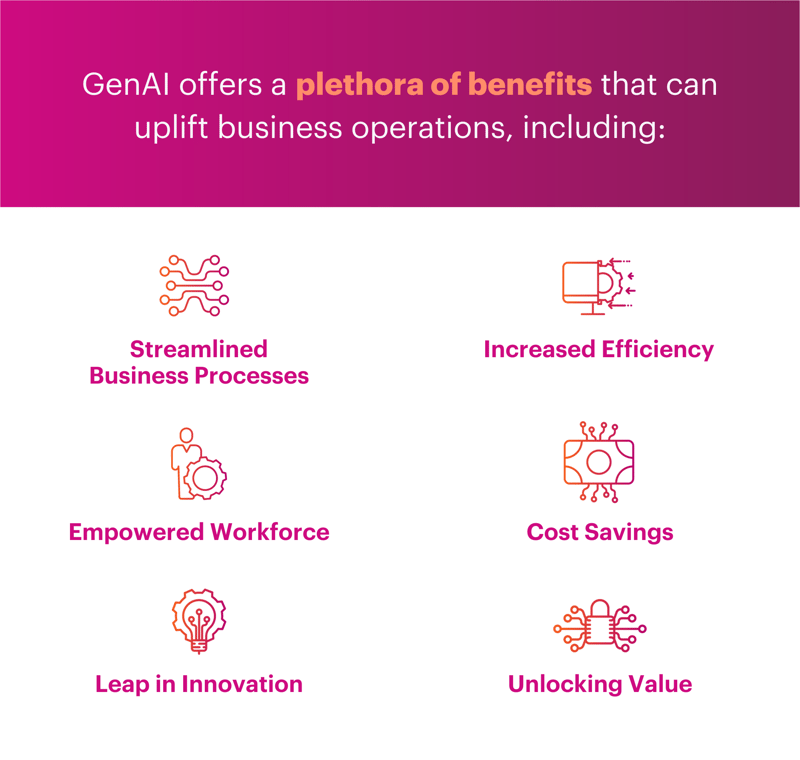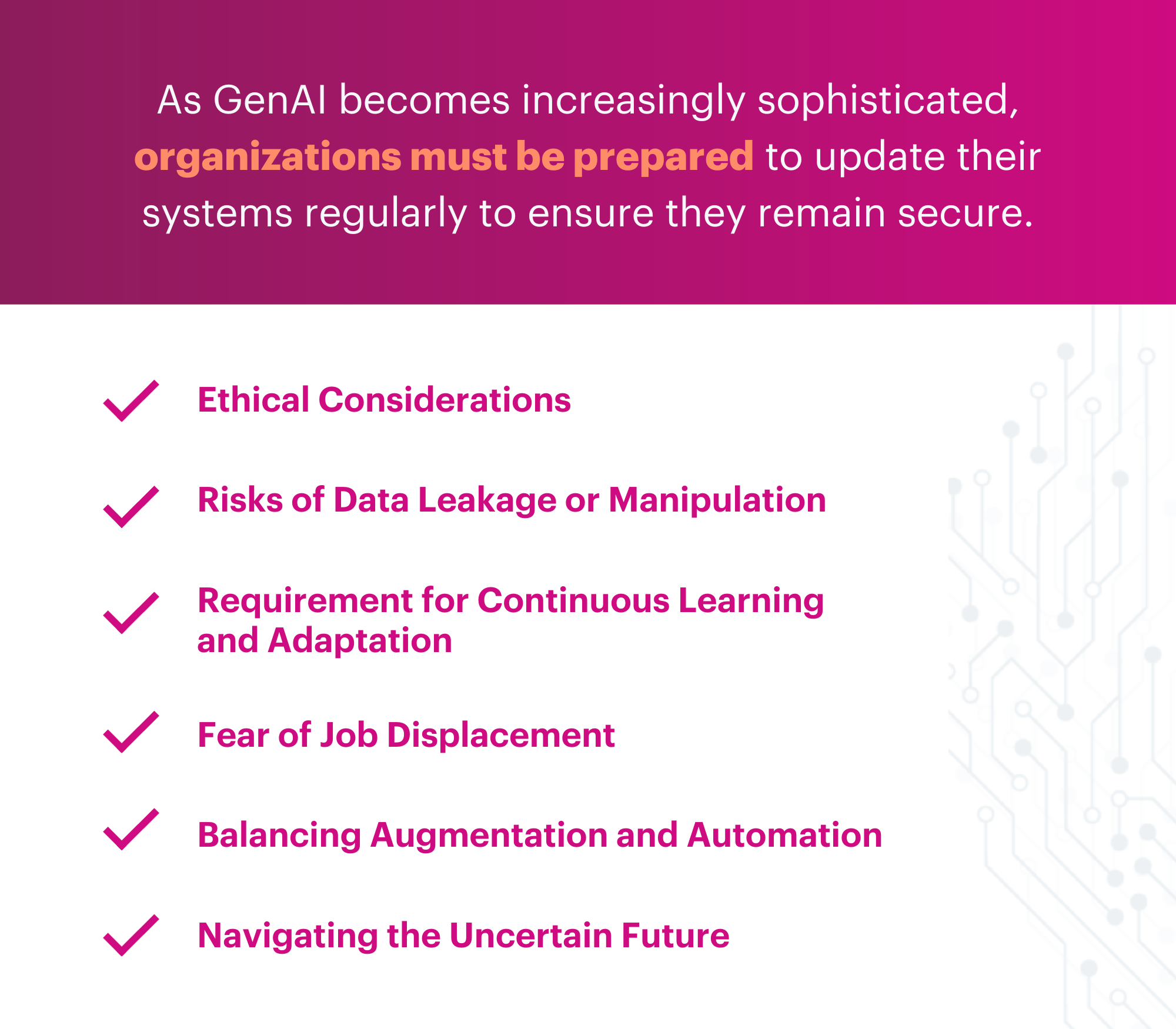Generative AI: Pros, Cons, and Why It’s Transforming the Workplace
A remarkable shift is underway—one that challenges conventional notions of work and the role of human workers. At the forefront of this transformation is Generative AI (GenAI), a form of artificial intelligence that can create new content by learning from existing data. This powerful tool has the potential to reshape our work.
Curious about how Generative AI can enhance your business? Book a demo with Aura today and uncover actionable insights for your workforce.
GenAI encompasses a spectrum of AI technologies that can create new content, mimic human thought processes, and enhance human capabilities. Its promise lies in automating repetitive tasks, but a central question emerges: Will GenAI primarily improve existing jobs, create new jobs, or lean towards automation, potentially replacing human roles?
While valid concerns about job displacement exist, it's crucial to remember that GenAI falls short in tasks requiring creativity, problem-solving, and empathy—skills inherently human. As organizations explore GenAI's potential, augmentation and automation will likely define the future workplace.
To fully harness GenAI's benefits, companies must understand their workforce structure, identify areas ripe for augmentation and automation, and implement GenAI strategically based on use cases and industry context.
In this new era, a delicate balance must be struck between harnessing AI's potential and preserving the human element. Companies that master this balance can gain efficiency, productivity, and innovation, ensuring a harmonious future where technology and humanity coexist. AI has enormous potential to grow, evolve, and adapt to new market conditions, providing unparalleled investor insights and portfolio returns.
GenAI Benefits: Advantages for Modern Workplaces
Generative AI has tremendous potential to streamline business processes, improve efficiency, and free up employees for more creative work. It can produce highly accurate data-driven insights in seconds, make quick and reliable decisions, automate processes, and generate new content. By taking over mundane tasks, GenAI can enable employees to focus on more meaningful work and help companies reduce costs associated with hiring and training staff.
Generative AI Tools and Models: Shaping the Future
Generative AI tools and models are at the forefront of innovation, offering a vast array of applications across numerous industries. These technologies enable the creation of synthetic data, which can be used to train AI systems more effectively.
As we explore the potential of Generative AI, it becomes clear that its benefits extend far beyond content creation and automation. GenAI's applications are diverse and impactful, from predictive maintenance to personalized treatment plans. Companies can leverage these tools to gain valuable insights into market trends and customer experiences, enhancing their competitive edge. Organizations can unlock enormous potential and drive efficiency in their business operations with a focus on responsible use and a thorough grasp of AI's capabilities.
GenAI can deliver highly accurate data insights in seconds, rendering quick and reliable decisions. It excels in automating tasks and generating fresh content, transforming how businesses operate. It can also help promote creative, divergent thinking by making associations among remote concepts and producing ideas drawn from them.
By taking on the mundane and repetitive, GenAI empowers employees to channel their energies into more meaningful endeavors. Concurrently, it aids companies in curbing the costs linked to staff hiring and training.
GenAI offers many benefits and advantages that can elevate business operations. Its potential to optimize processes, enhance efficiency, and expand human capabilities for innovation is a compelling proposition. It's a technological leap that promises a more streamlined and cost-effective future and a workplace where creativity thrives, making it an enticing opportunity for investors seeking transformative ventures in the tech space.
With its advanced features, intuitive interface, and data analytics, it has the potential to transform the way investors allocate their financial resources and make investment decisions in the tech space. GenAI can help investors identify emerging trends, access valuable insights, and track their portfolio's performance, leading to better outcomes and higher profits in the long run. GenAI will become a key player in the workforce as the tech space continues to evolve.

Challenges of GenAI: Balancing Benefits and Risks
Although there are many benefits to using GenAI in the workplace, it also presents some challenges. There is currently limited regulation surrounding AI technologies, so companies must adhere to ethical standards and not exploit the technology for unethical purposes. Responsible use is crucial to avoid risks such as data leakage or manipulation.
Additionally, if GenAI is misused or malfunctions, there is a risk of data leakage or manipulation, so it’s essential to have measures in place to protect against these risks.

Ultimately, Generative AI has the potential to revolutionize the way businesses operate. Still, organizations must be aware of the risks associated with its use and take steps to ensure it is used responsibly and securely. By doing so, companies can benefit from improved efficiency and cost savings while minimizing risk exposure.
As Generative AI (GenAI) continues to advance, it is clear that the technology is a game changer for numerous industries. These AI tools offer a competitive edge by providing data-driven insights and predictive analytics that help businesses stay ahead of market trends. Generative AI models are adept at analyzing data, including unstructured data, to produce fresh content and personalized recommendations.
This powerful tool streamlines business operations and enhances customer experiences by addressing customer inquiries more efficiently.
However, as organizations harness GenAI's enormous potential, they must ensure responsible use to mitigate concerns related to data security and ethical considerations. Prompt engineering and understanding synthetic data will be pivotal as AI applications evolve, allowing businesses to create more innovative solutions and reduce costs while maintaining a thorough grasp of their operational needs.
GenAI in the Workforce: Benefits, Risks, and Future Trends
GenAI represents a significant opportunity to optimize resource allocation, considering potential augmentation and automation use cases. While some functions are inherently more likely to be strengthened by GenAI than others, a detailed workforce analysis is necessary to understand roles and tasks, identify opportunities for augmentation or automation, and size the potential benefits to enable business value creation.
The potential impacts of AI on the workforce are vast and far-reaching. Assessing what tasks can be automated or augmented with GenAI is necessary. Automated processes that previously required manual intervention (e.g., data entry tasks) will become faster and more efficient with AI-driven automation.
Additionally, roles traditionally seen as purely creativity-based or requiring deep experience and expertise (e.g., product design or financial analysis) will become augmented with GenAI, allowing employees to spend less time on manual tasks and more time on higher-value activities.
As AI technology becomes more advanced, it can detect patterns in data quickly and accurately, leading to improved decision-making based on predictive analytics. Finally, GenAI can improve customer service and engagement by allowing companies to respond promptly to customer inquiries and provide personalized recommendations. Using GenAI helps organizations become more efficient, agile, and competitive in today's digital era.
Harnessing the Full Potential of AI Applications
Artificial Intelligence, particularly Generative AI, is crucial in reshaping how businesses analyze data and gain insights. By leveraging AI applications, organizations can transform existing data into valuable insights and predictive models. Generative AI tools and technologies allow for the creation of synthetic data, which can support advanced data analytics and predictive maintenance. This capability is essential across many industries, from drug discovery to content creation, where vast amounts of unstructured data must be processed. Companies can also use these AI tools to automate data entry tasks and repetitive processes, significantly reducing costs and enhancing productivity.
As AI evolves, its benefits become increasingly apparent, including individualized support and the ability to precisely address customer inquiries. Embracing these innovations positions businesses at the forefront of the new era in technology, where the integration of AI represents a game changer in achieving operational efficiency and a competitive edge.
GenAI Pros and Cons: Balancing Innovation and Security
In reshaping the workforce, it is crucial to differentiate between augmentation and automation. Augmentation refers to integrating AI technologies to empower human workers, making them more productive and efficient. On the other hand, automation refers to GenAI automating tasks previously performed by humans, leading to job displacement.
The primary goal of augmentation is not to replace humans but to enhance their capabilities. With AI's assistance, humans can complete tasks faster, analyze data more accurately, and make informed decisions. This form of AI is a tool that complements human work.
On the other hand, automation refers to AI taking over tasks that humans previously performed. Automation aims to complete tasks faster and more efficiently than humans, reducing labor costs.
While automation raises concerns of job displacement, augmentation empowers humans with AI. By delegating repetitive tasks to AI, workers can focus on more complex and creative aspects of their jobs. AI can enhance job satisfaction as employees engage in meaningful and intellectually stimulating tasks.
With the integration of AI, specific jobs will be redefined, and some tasks will be delegated to machines. For instance, in customer service, chatbots can handle repetitive and straightforward queries, while humans can control complex conversations. This division of labor will allow humans to focus on more critical and creative tasks, enhancing their skills and capabilities.
With AI caring for menial and repetitive tasks, humans can focus on more complex and creative aspects of their jobs. For instance, in the legal field, AI can process documents and highlight relevant sections, allowing lawyers to focus on the content and make more informed decisions. Creativity thrives without dull and monotonous tasks, and AI can help us leverage new perspectives to tackle more challenging problems.
Training and education will be crucial to enhance human capabilities as AI continues to evolve. Individuals must learn how to work with AI to reach their full potential. For instance, data literacy skills are becoming essential, and employees must learn how to interpret data to make informed decisions. To stay up-to-date with the latest technological advancements, training, and education programs should adapt to meet new skill demands.

The success of GenAI's integration into the workforce depends on how organizations and individuals handle the delicate balance between harnessing AI's potential and safeguarding the human workforce. As a workforce analytics tool, Aura can help understand skills in a particular company or industry.
Clustering these skills can help us understand AI's impact on that workforce. As we navigate this new era, the augmentation vs. automation dilemma reminds us that technological progress is an opportunity for evolution, adaptation, and innovation.
Transform Your Workforce with Generative AI Insights from Aura
Generative AI (GenAI) is reshaping the future of work, offering unprecedented opportunities to enhance productivity and creativity. However, it's crucial to balance leveraging AI's capabilities and preserving the unique value of human ingenuity.
At Aura, we specialize in empowering businesses to harness GenAI's full potential as applied to workforce and data analytics. Our advanced workforce analytics platform delivers actionable insights that drive efficiency, innovation, and strategic decision-making.
Curious about the benefits of Generative AI for your workplace? Aura’s workforce analytics platform helps you harness AI for improved efficiency, innovation, and decision-making. Book your free demo today to explore actionable insights.



